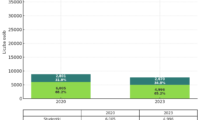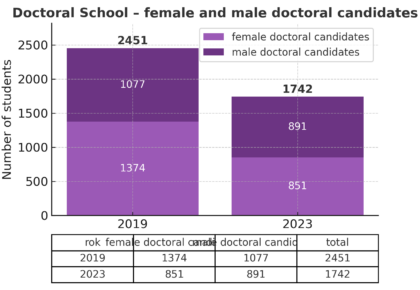Gender structure of students at the University of Warsaw
Gender structure of 1st, 2nd and long cycle students at the University of Warsaw
The number of all students at the University of Warsaw decreased between 2020 and 2023 from 40,247 to 36,300.
The number of female students decreased from 25,779 to 22,381, while the number of male students decreased much less – from 14,468 to 13,919. As a result, the percentage of female students decreased from 64.1% to 61.7%, while the percentage of male students increased.
The number of full-time students decreased from 31,441 to 28,634. Female students contributed the most to this decline—their number decreased from 19,774 to 17,385, corresponding to a decrease in their participation from 62.9% to 60.7%. The number of full-time students decreased from 11,667 to 11,249, resulting in an increase in their participation to 39.3%.
The number of part-time students decreased from 8,806 to 7,666. In particular, the number of part-time female students decreased from 6,005 to 4,996, corresponding to a decrease in their share from 68.2% to 65.2%. The number of part-time men decreased slightly from, which relatively increased.
Gender structure of PhD candidates at the University of Warsaw
In recent years, we have observed an interesting shift in the gender composition of doctoral students at the University of Warsaw.
In 2019, the total number of doctoral candidates was 2,451 (1,374 women, 1,077 men), with women accounting for approximately 56.1%. In 2023, the number of doctoral students decreased to 1,742 (851 women, 891 men); the share of women fell to 48.9%, and the share of men increased to 51.1%. The overall decline was -28.9%, with 523 women and 186 men.
Despite the significant decline in the overall number, a relative change in gender representation is visible – over the past four years, the gender composition has approached balance.
Gender structure of post-graduate students at the University of Warsaw
Postgraduate studies at the University of Warsaw have been very popular for years, especially among women.
In 2019, women accounted for a staggering 77.3% of participants (1,613), while men accounted for only 22.7% (473). In 2023, these proportions changed slightly – the share of women dropped to 74% (1,565), and men increased to 26% (551).
The total number of students increased from 2,086 to 2,116 during this period, demonstrating that interest in this form of education remains high and stable.
At the same time, a slight increase in the share of men is visible, fostering the development of diversity within this group.





